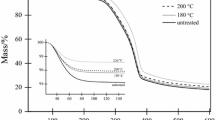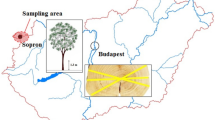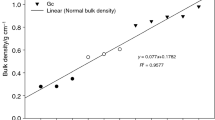Abstract
The paper focuses on the use of thermogravimetric analysis (TGA) as a fast method for estimating the change of lignocellulosic materials during fungal degradation in laboratory trials. Traditionally, evaluations of durability tests are based on mass loss. However, to gain more knowledge of the reasons for differences in durability and strength between wooden materials, information on the chemical changes is needed. Pinus sylvestris sapwood was incubated with the brown rot fungus Gloeophyllum trabeum and the white rot fungus Trametes versicolor. The TGA approach used was found to be reproducible between laboratories. The TGA method did not prove useful for wood deteriorated by white rot, but the TGA showed to be a convenient tool for fast estimation of lignocellulosic components both in sound wood and wood decayed by brown rot.


Similar content being viewed by others
References
Beall FC (1969) Thermogravimetric analysis of wood lignin and hemicelluloses. Wood Fiber Sci 1(3):215–226
Carrier M, Loppinet-Serani A, Denux D, Lasnier JM, Ham-Pichavant F, Cansell F, Aymonier C (2011) Thermogravimetric analysis as a new method to determine the lignocellulosic composition of biomass. Biomass Bioenergy 35:298–307
Crawford RL (1981) Lignin biodegradation and transformation. Wiley, New York
Dence CW (1992) The determination of lignin. In: SY Lin, Dence CW (eds) Methods in lignin chemistry. Springer, Berlin, pp 33–62
EN 113 (1996) Wood preservatives—Test method for determining the protective effectiveness against wood destroying basidiomycetes—Determination of toxic values. Brussels, Belgium, European Committee for Standardization (CEN)
Enoki A, Tanaka H, Fuse G (1989) Relationship between degradation of wood and production of H2O2-producing or one-electron oxidases by brown-rot fungi. Wood Sci Technol 23:1–12
Grønli MG, Varhegyi G, DiBlasi C (2002) Thermogravimetric analysis and devolatilization kinetics of wood. Ind Eng Chem Res 41:4201–4208
Jeguirim M, Dorge S, Trouve G (2010) Thermogravimetric analysis and emission characteristics of two energy crops in air atmosphere: Arundo donax and Miscanthus giganthus. Bioresour Technol 101(2):788–793
Orfao JJM, Antunes FJA, Figueiredo JL (1999) Pyrolysis kinetics of lignocellulosic materials-three independent reactions model. Fuel 78:349–358
Popescu CM, Lisa G, Manoliu A, Gradinariu P, Vasile C (2010) Thermogravimetric analysis of fungus-degraded lime wood. Carbohydr Polym 80:78–83
Tappi Standard (2000) T 249. Cm-00, Carbohydrate composition of extractive-free wood and wood pulp by gas-liquid chromatography
Tappi Standard (1998) T 204. Cm-07, Solvent extractives of wood and pulp
Tappi Standard (1983) T 222. Cm-00, Acid in-soluble lignin in wood and pulp
Zabel RA, Morrell JJ (1992) Wood microbiology—decay and its prevention. Academic Press, San Diego, 476 pp
Acknowledgements
The authors gratefully acknowledge the financial support of WoodWisdom-Net (www.woodwisdom.net), the wood industry partnership Building with Wood, and The Research Council of Norway for funding the research work within project “WoodExter”. This work forms part of that project. Also, thanks to Monica Fongen and Eva Grodås, Norwegian Forest and Landscape Institute, and to Thomas Koch, Vienna University of Technology for their work on the TGA.
Author information
Authors and Affiliations
Corresponding author
Rights and permissions
About this article
Cite this article
Alfredsen, G., Bader, T.K., Dibdiakova, J. et al. Thermogravimetric analysis for wood decay characterisation. Eur. J. Wood Prod. 70, 527–530 (2012). https://doi.org/10.1007/s00107-011-0566-7
Received:
Published:
Issue Date:
DOI: https://doi.org/10.1007/s00107-011-0566-7




